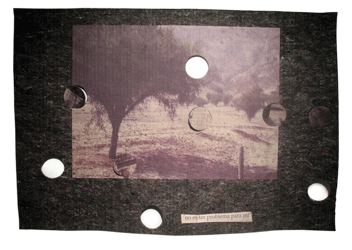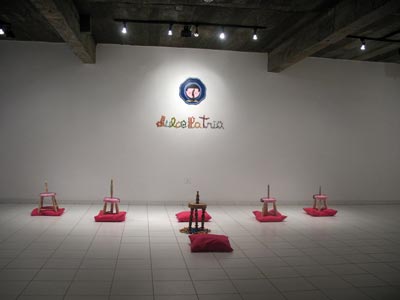The Campo Expandido (Expanded Field) exhibit, currently underway at the Migliorisi Foundation, showcases the works of three contemporary Chilean artists: Ricardo Villarroel, Mario Ibarra (Paté) and Antonio Guzman. The trio is bound together by their academic formation in the arts and their teaching stints both in this area and in research –an activity they carry out in their respective works. The three of them work on art theoretical concepts that spread to studied curatorship –executed all by themselves as well– and expressed in unified visual proposals.
They think everything together, from the discourse and the management to the mounting and the communicative field, either about the exposed pieces or their linkage to the spectator. This working threesome marks off a broader territory in form and correspondence, a space that clusters all by itself more diversity and more possibilities. As they explain in the presentation to their exhibit, its title dates back to the “expanded field” concept coined by Rosalind Krauss, an American art critic and professor. This concept hinges on the premise that the extension of the artistic categories –like painting and sculpturing– paves the way for the creation of new interceptions that stretch out the limits and allow for the renewal of relationship strategies with the environment/context. In this case –according to the abovementioned artists– it’s a relook into their country that has either apparently neglected its memory or resorted to the possibility of being looked at only as a representation.
In his essay entitled The Shams, Baudrillard recalls a story about the Borges, about a map so detailed –that is, a representation– that panned out to be a one-on-one correspondence with the charted territory. Based on this story, the French theoretician writes that since the postmodern era it has been impossible to tell apart the concepts of map and territory since the differences that existed between the two of them have been rubbed out. Furthermore, he insists that among the receiver of hyper reality this condition plays a passive role; therefore, in this context there’ll be no such thing as a construction of independent sense. Hooked up with this reflection and in an effort to reestablish that allegedly blurred memory of their country, these three artists rely –in their creative outlines– on memories and experiences as they reassess the synthesis between the political and the stripped, the social and the personal, the moralist and the artistic, but always wary of the meta-narrations that intend to put a unique spin on the course of history.

Ricardo Villarroel appeals to the use of felt as his material of choice and an invoker of different meanings. Felt is a cloth whose main feature lies in the fact that in the making process no fabrics are required. It just takes a clustering process –through steam and pressure– of several layers of wool and fur from different animals. The process itself comes like some sort of piled-up stories. In the same breath, this blanket-shroud endures some striking and embossing –absences and presences, openings and wrappings– to figurate/conceal several possible elucidations such as a territory devastated by the force nature and mankind –social and political earthquake- the deployment of felt as an allusion to the field, and last but not least, felt is also shown as “a daily landscape” in which the presence of original clipped words that make up press headlines, coupled with images captured by the artist and transferred to the suggestive texture –text and context– are pieced together.
Mario Ibarra (Paté) comes up with a series of large-scale oils on canvas in which national cartography is threatened by images that speak of amputations, ensembles and disasters. These paintings are complemented by an object piece faced off, on the one hand, by its own representation in the form of a plotter and, on the other hand, by a video that narrates an assortment of situations in uneven scenarios on the artist’s personal fable. By doing so, he’s sharing the limelight with characters taken from Chile’s popular culture. Even though different discourses can be seen, Paté says, “I’m a painter, and everything comes out of or stems from my painting.” He accepts the principle of contradiction, doubt used as a metaphor, the crossing as an element. Resting on the idea of transit, the connective axis of his pictorial discourse is a break point that allows for the skewing of the glimpse; a world of experiences, the sketch of a biographical note. A feature that paints an ever-changing identity.

Antonio Guzman banks on everyday objects, all of them intervened and de-contextualized, whereby he weaves symbolic association that spark unrest in the spectator’s input. His idea revolves around the dislocations of the sense established by those objects –a map of Chile made up of jellybeans– the generation of a metamorphosis to the material –wooden seats for children that have been painted and altered– and the scope of the new semantics –an image of Pinocchio as the main linking thread– in which the children’s tale is disguised, disturbed and breached. The most worrying of all the pieces is the intervention he made on the recreation of a figurative painting entitled “Geography Lesson” by celebrated Chilean painter Alfredo Valenzuela Puelma (1856-1909). The objects recreated by Guzman acquire a weird reality: they do exist, but they are different. However, his works do not emerge as a result of a crisis of the visible, but of the sensation that the reality we perceive is dangerously tethered to, sweetened and covered by cultural codes. Thus, these three Chilean artists attempt to recreate their own context, come up with new anchorage cleats through art’s elusive files. In this particular sense, their joint works –it’s good to underscore that point– open up to new fields that, thanks to the world’s apprehension problems and by the hand of the ontological, come down hard on an issue of commitment to everything that surrounds them. At the end of the day, delving deeper into the relationship of the individual with his own reality means a displacement that binds esthetics and ethics closer together.
Asuncion, Aug. 24, 2010
Related Publications

How Harumi Yamaguchi invented the modern woman in Japan
March 16, 2022












